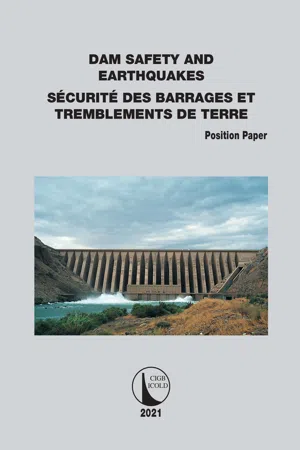
- 14 pages
- English
- ePUB (mobile friendly)
- Available on iOS & Android
Position Paper Dam Safety and Earthquakes
About This Book
Earthquakes have always been a significant aspect of the design and safety of dams. This position paper deals with the seismic safety of large dams, based on experiences with large earthquakes in Japan (Tohoku earthquake, 2011, Richter magnitude 9.0), in China (Wenchuan earthquake, 2008, Richter magnitude 8.0) and in Chile (Maule earthquake, 2010, Richter magnitude 8.8). It presents ways to prevent key aspects of large dam failure under severe seismic conditions with a focus on design instead of on earthquake prediction. This is done by considering the prevention of uncontrolled rapid release of water of a storage dam under full reservoir conditions in relation to expected seismic conditions.
This position paper is composed by the Committee on Seismic Aspects of Dam Design of The International Committee of Large Dams.
Les tremblements de terre ont toujours été un aspect important de la conception et de la sécurité des barrages. Ce document de synthèse traite de la sécurité sismique des grands barrages, en se fondant sur l'expérience acquise lors de grands séismes au Japon (séisme de Tohoku, 2011, magnitude 9, 0 sur l'échelle de Richter), en Chine (séisme de Wenchuan, 2008, magnitude 8, 0 sur l'échelle de Richter) et au Chili (séisme de Maule, 2010, magnitude 8, 8 sur l'échelle de Richter). Il présente des moyens de prévenir les aspects clés de la défaillance des grands barrages dans des conditions sismiques sévères en mettant l'accent sur la conception plutôt que sur la prévision des séismes. Pour ce faire, on examine la prévention d'une libération rapide et incontrôlée de l'eau d'un barrage de stockage dans des conditions de réservoir plein par rapport aux conditions sismiques prévues.
Cet argumentaire est composé par le Comité sur les Aspects Sismiques des Projets de Barrages de la Commission Internationale des Grands Barrages.
Frequently asked questions
Information
COMMITTEE ON SEISMIC ASPECTS OF DAM DESIGN
COMITÉ SUR LES ASPECTS SISMIQUES DES PROJETS DE BARRAGES
Chairman / Président |
|
Switzerland / Suisse |
M. WIELAND |
Members / Membres |
|
Australia / Australie |
I. LANDON-JONES |
Austria / Autriche |
G. ZENZ |
Argentina / Argentine |
J. CARMONA |
Bulgaria / Bulgarie |
M. PETKOV |
Canada |
K. ADDO |
Chile / Chili |
F. RAMOS |
China / Chine |
H. WANG |
Colombia / Colombie |
C. MARULANDA |
Costa Rica |
A. CLIMENT |
Egypt / Egypte |
A. RASHED |
Ethiopia / Ethiopie |
A. AMAN |
Germany / Allemagne |
K. TERHEIDEN |
India / Inde |
R. VISHNOI |
Iran |
S. AHMADI ADLI |
Italy / Italie |
R. CARUANA |
Japan / Japon |
T. SASAKI |
Korea (Rep. of) / Corée (Rép. de) |
D. KIM |
Macedonia (Rep. of North) / Macédoine du Nord (Rép. de) |
L. PETKOVSKI |
Mexico / Mexique |
M. ROMO |
New Zealand / Nouvelle Zélande |
T. MATUSCHKA |
Norway / Norvège |
K. HOEG |
Portugal |
P. SECO E PINTO |
Russia / Russie |
A. BUGAEVSKY |
Spain / Espagne |
F. BLAZQUEZ PRIETO |
Sri lanka |
B. KENDARAGAMA |
Thailand / Thaïlande |
T. HARNPATTANAPANICH |
United Kingdom / Royaume-Uni |
L. SPASIC-GRIL |
United States / États-Unis |
L. MEJIA |
Introduction
Table of contents
- Cover
- Title Page
- Copyright Page
- Committee on Seismic Aspects of Dam Design
- Introduction
- What Earthquake Action Does a Dam Have to Withstand?
- Seismic Hazard is a Multi-Hazard
- What Could Happen in the Case of Strong Earthquakes?
- Could Reservoirs Be Lowered in Case of Successful Earthquake Predictions?
- Can Earthquakes Be Triggered by Storage Dams?
- What are the Main Concerns with Respect to the Earthquake Safety of Large Storage Dams?
- The Role of ICOLD
- Conclusions
- Photos Related to Dam Safety and Earthquakes